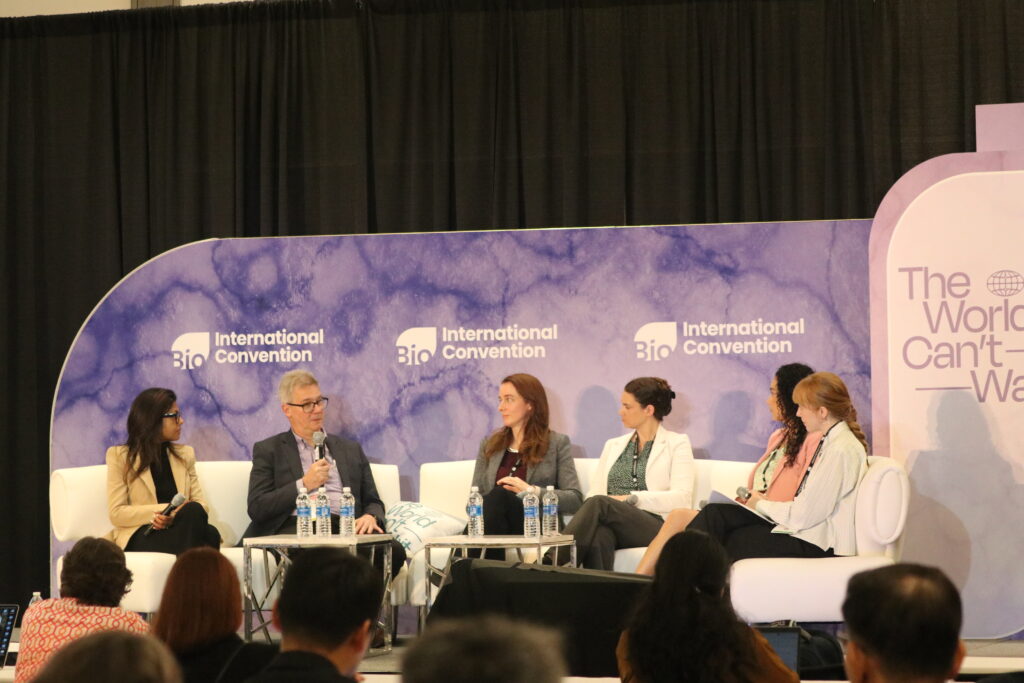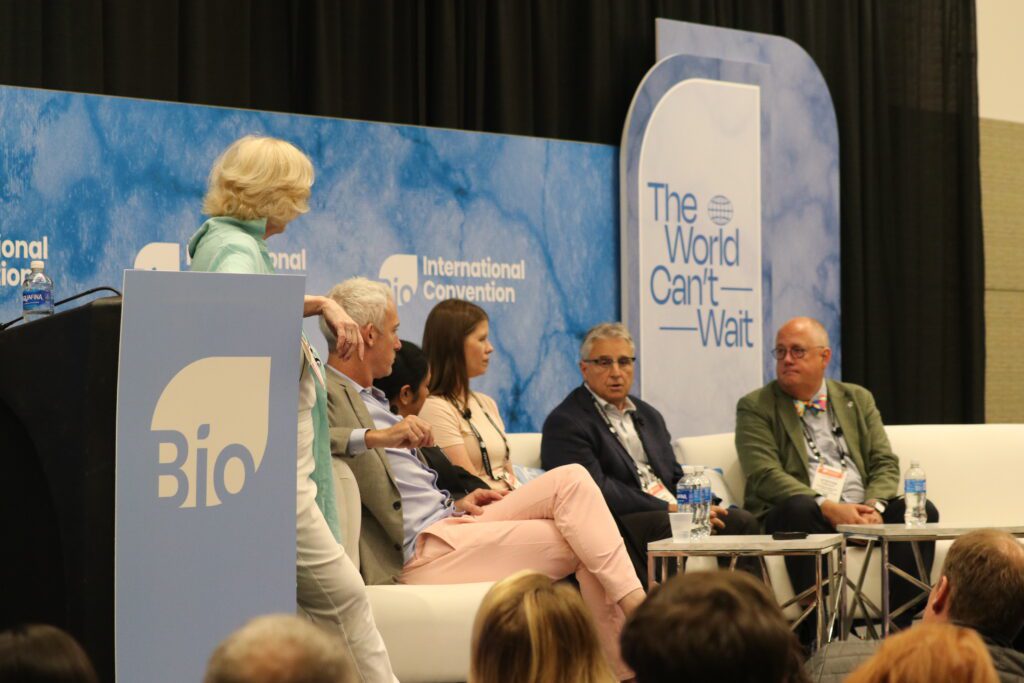Given the essential role that intellectual property plays in the development of lifesaving scientific advances, we need to defend and strengthen policy that protects IP, according to a panel of biotech experts.
“Patents and other IP protections support the high-risk, high-cost journey from early research to real treatments,” said Sarah Alspach, Executive VP and Chief Communications Officer of the Biotechnology Innovation Organization (BIO). Alspach moderated a panel on IP rights at the BIO International Convention in Boston in June 2025.
The U.S. system drives R&D and commercialization of new treatments by making IP a valuable asset that can provide returns for investors, said panelist Joseph Allen, Executive Director of the Bayh-Dole Coalition.
Allen worked on establishing that system as an aide to Rep. Birch Bayh (D-IN), co-sponsor of the 1980 Bayh-Dole Act, which allows IP from government-funded research to be privately patented and commercialized. Panelists agreed that Bayh-Dole has been essential to driving the innovation that has made America the world leader in developing new drugs.
“Our system works. It’s been working for 45 years now, and I think it’s important to all of us that you take the time to educate the public, the media, and American taxpayers—or the system can go back to being dysfunctional, like it was before 1980,” said Allen, whose coalition concentrates on this kind of education.
How IP works to support drug development
“IP really enabled every drug that’s coming to the market today,” said Erika Smith, CEO of EpiTET Therapeutics. She gave the example of early investment.
“Universities really play a foundational role in that first IP, the first protection that you have within the company. And without IP, you really don’t have the piece to invest in, so it’s absolutely critical,” Smith said. “It’s not an optional thing. It’s required to be able to attract capital.”
Noting the role of IP in the initial research stage, John Glasspool, CEO of VarmX, reminded the panel that IP is essential throughout the entire drug development lifecycle. Those who fund clinical trials need to know they will be able to recoup their investment thanks to secure and exclusive IP ownership, he said. And even the end of IP exclusivity, after roughly 12 years, is part of the cycle.
“The expiration of patent protection also spurs innovation because the companies that have those products reinvest and refocus their resources on more innovation,” he said. “From the birth of the product through to its death, if you will, IP is really critical to the dissemination and improvement of human health with these medicines.”
The former Deputy Director of the US Patent and Trademark Office, Laura Peter, agreed that IP’s expiration impacts innovation.
“The innovation goes back into the community where people can build off of that and create new innovation, stand on the giants—their forebears—and develop new creations,” she said.
Executive and legislative decisions impacting IP
Exclusive licensing and institutional control of IP—especially under the Bayh-Dole framework—is essential to the system that encourages drug development, panelists said. But they also acknowledged the role of government support and raised concerns about the new administration’s reductions in government grants, particularly those from the National Institutes of Health (NIH) for medical research.
“We’re seeing cuts in federal research funding,” Alspach said. They raise the question: What is the government’s role in backing basic research?
After World War II, the U.S. shifted basic research funding toward universities rather than conducting it within government agencies—a strategy formalized by the Bush report, Peter explained.
Allen noted that the basic research the NIH often funded in universities was advancing science but not necessarily yielding new medicines. “Without people in the industry, typically small companies, that’s not going to be developed,” he said.
Still, the panelists agreed that the government’s role in supporting R&D in universities is essential. “I believe firmly that the government should continue to fund basic and fundamental research,” said Peter.
“If we stop that now, we stop not only the pipeline,” she added, “we will be encouraging non-U.S. researchers to not stay in America. and we want the best and the brightest to come to America.”
As for congressional action, there was recognition of some important allies, but also concern about legislation that might weaken IP.
“We can find very strong Democrat support and very strong Republican support,” said Peter, noting influential IP backers on the Senate Judiciary Committee: Sens. Thom Tillis (R-NC) and Chris Coons (D-DE). In the House, she named Reps. Jake Auchincloss (D-MA) and Deborah Ross (D-NC).
There are also anti-patent sentiments in Congress, driven in part by concerns about the concentration of big tech, but reducing IP would be catastrophic for biotech, according to Peter.
“I think that’s kind of the biggest challenge is informing and educating our legislators and our communities about the power of IP,” she said.
Concerns about march-in abuse
One attack on the power of IP comes from calls to misuse the Bayh-Dole “march-in rights.” Under the Bayh-Dole Act, if the patent holder of a drug developed with federal support does not commercialize the drug, the government can “march-in” and give the patent to someone else.
The law only allows “march-in” under limited circumstances, like a public health crisis, and NIH has never used march-in rights. However, under the Biden Administration, the National Institute of Standards and Technology (NIST) submitted a framework to consider whether march-in rights could be used to take away patent rights when the price of a drug is deemed too high.
Allen’s Bayh-Dole Coalition recently wrote to President Trump, warning that the NIST’s framework had not yet been repealed. Allen explained that others had suggested this abuse of march-in rights in the past, and it remains important to remind people why it’s a bad idea.
“You have to keep going back over and over again. It’s not that people are dumb, but you have to educate people on how the law works,” he said.
“There’s this confusion about drug pricing and whether drug pricing is high because of patents and patentability. I would argue very vehemently, no—it is not the patents,” Peter added. “In fact, without the patents, we would not have the great innovations that we have today.”
She agreed with Allen that we need to convey this message to lawmakers.
“It is so important that you’re actually getting feedback from venture capitalists saying, ‘We may want to not consider investing in you if your IP rights aren’t really strong,’ ” Peter said. “Those kinds of stories need to get out and be available for our legislators so they actually understand it.”




